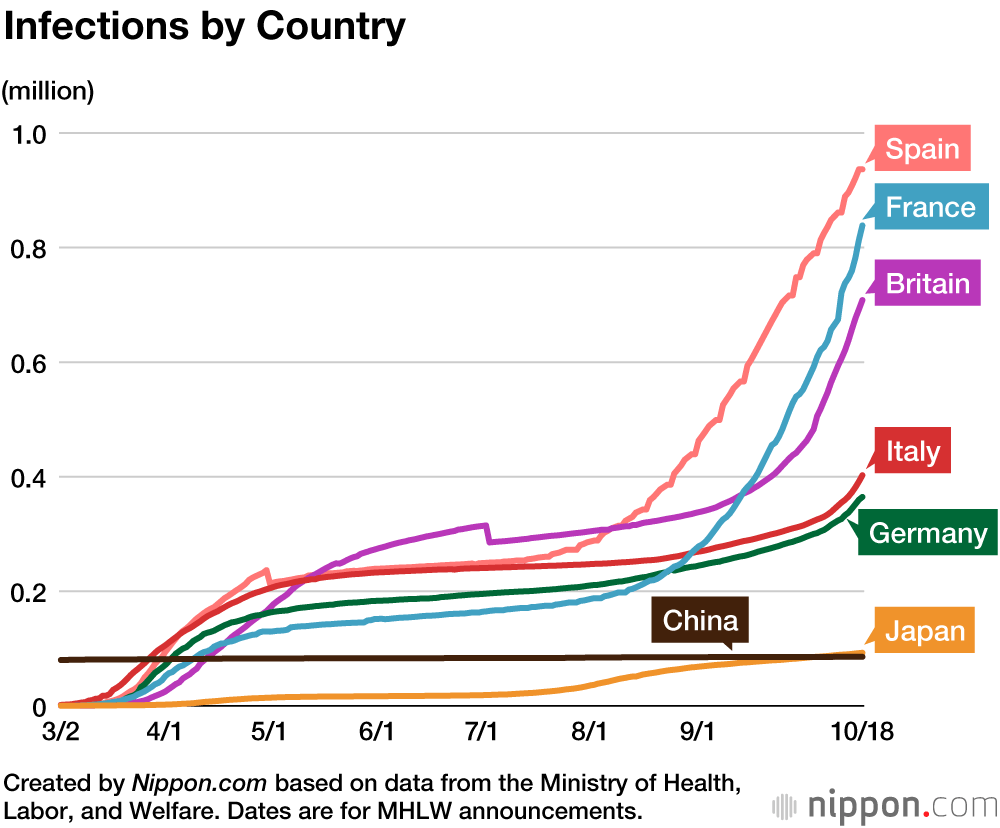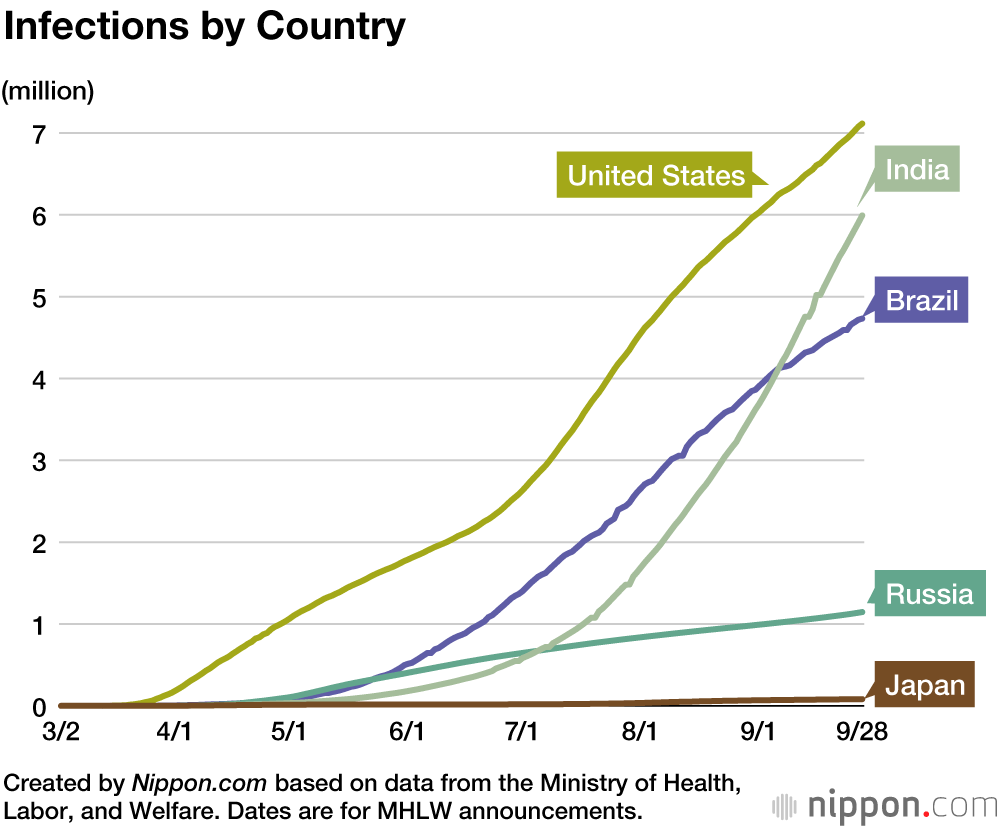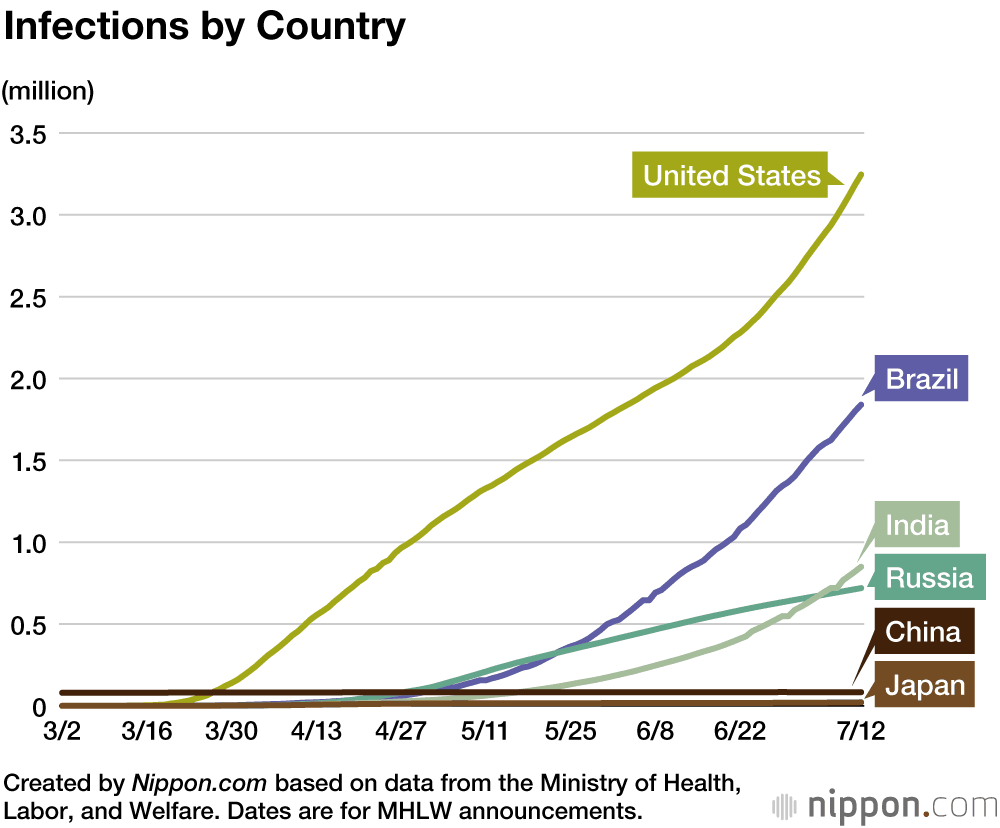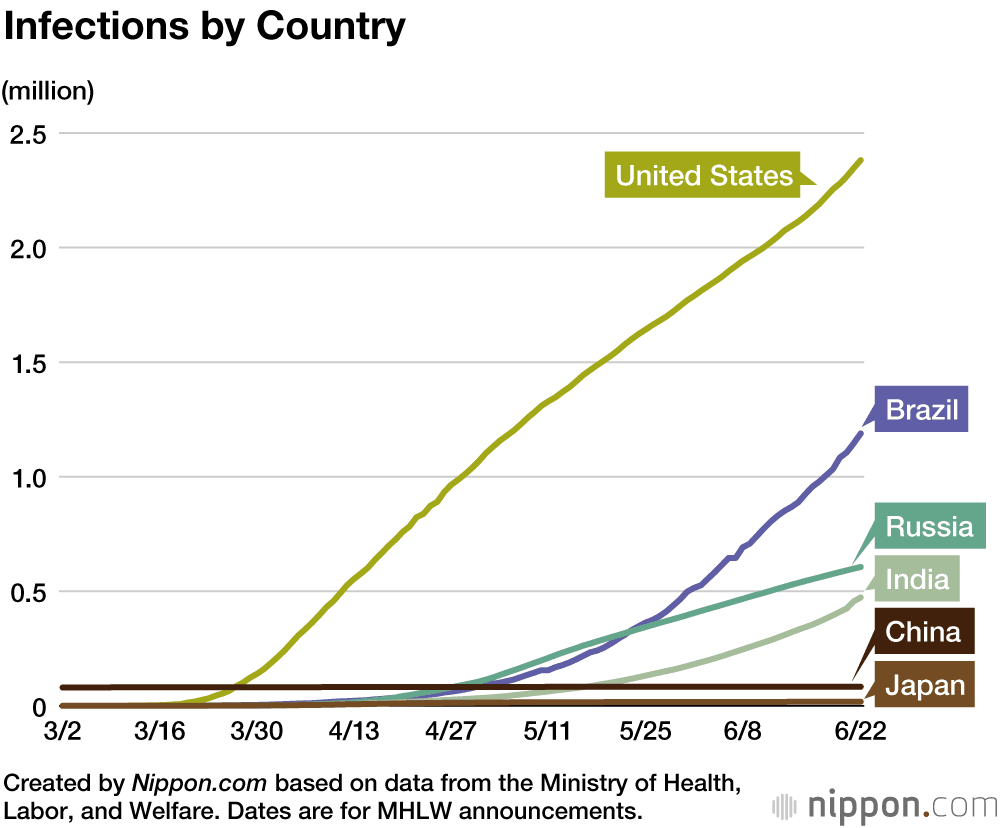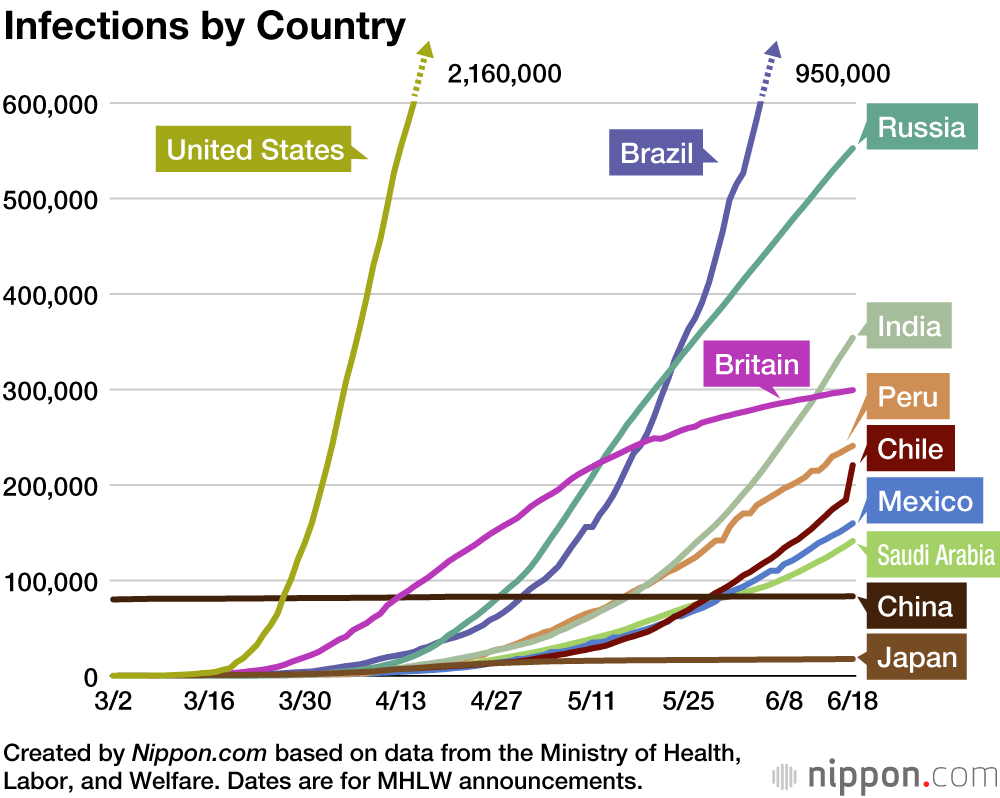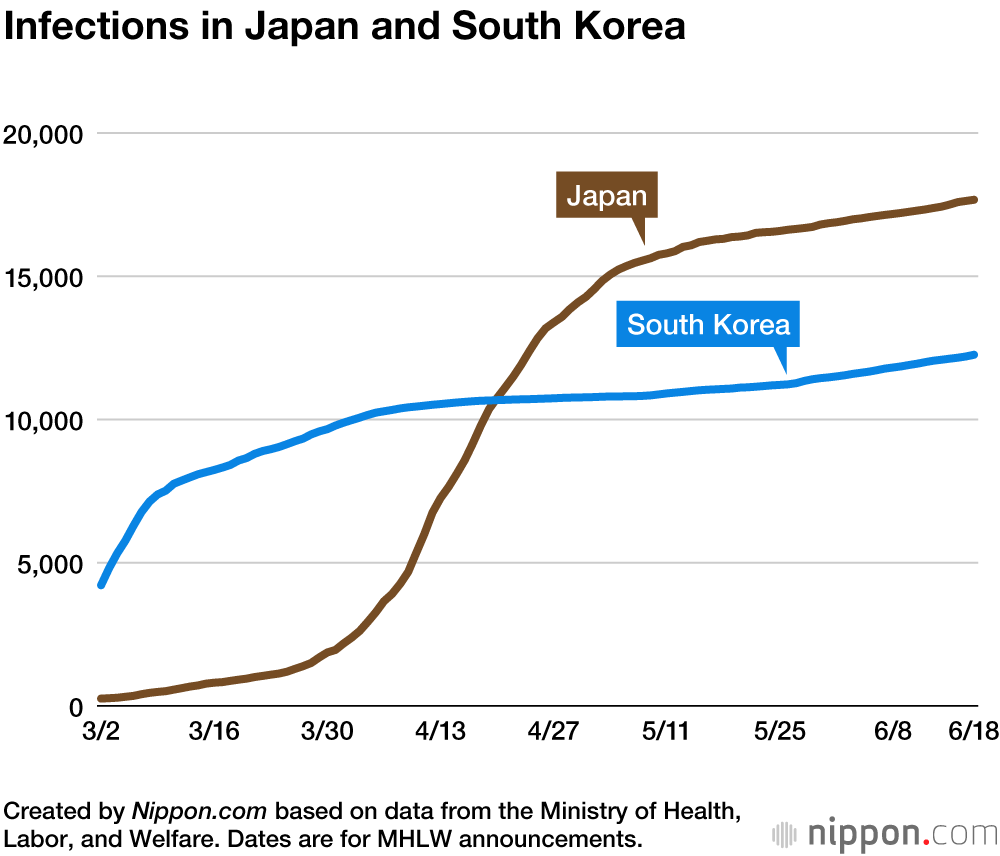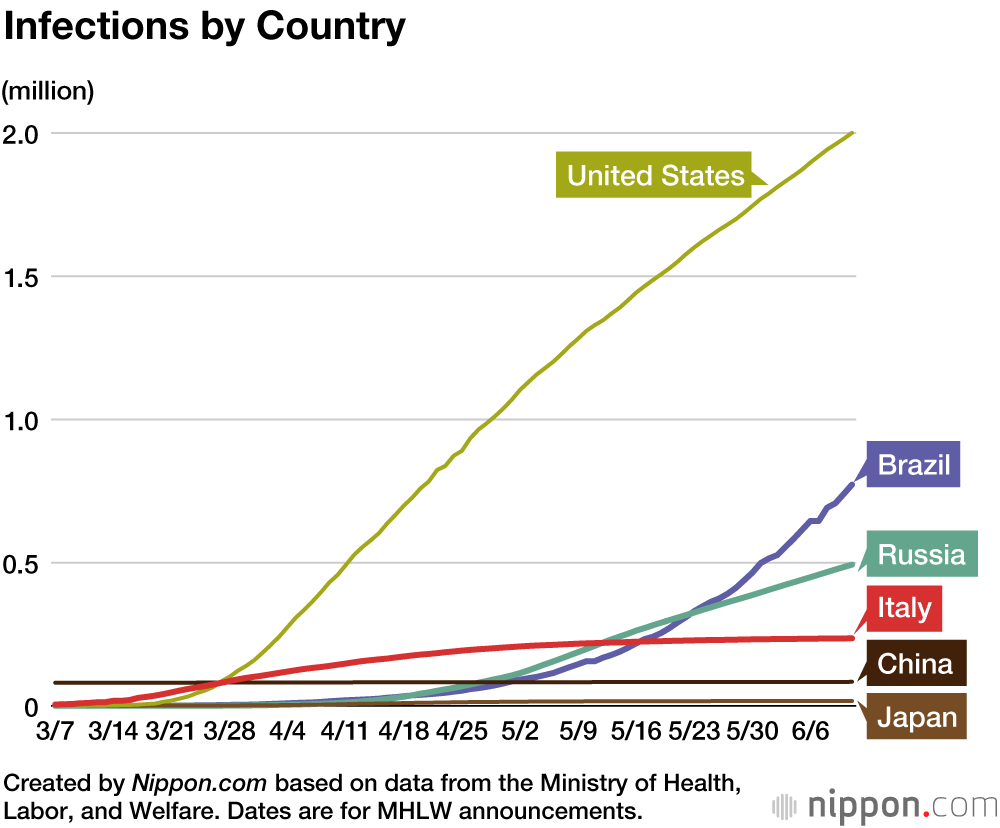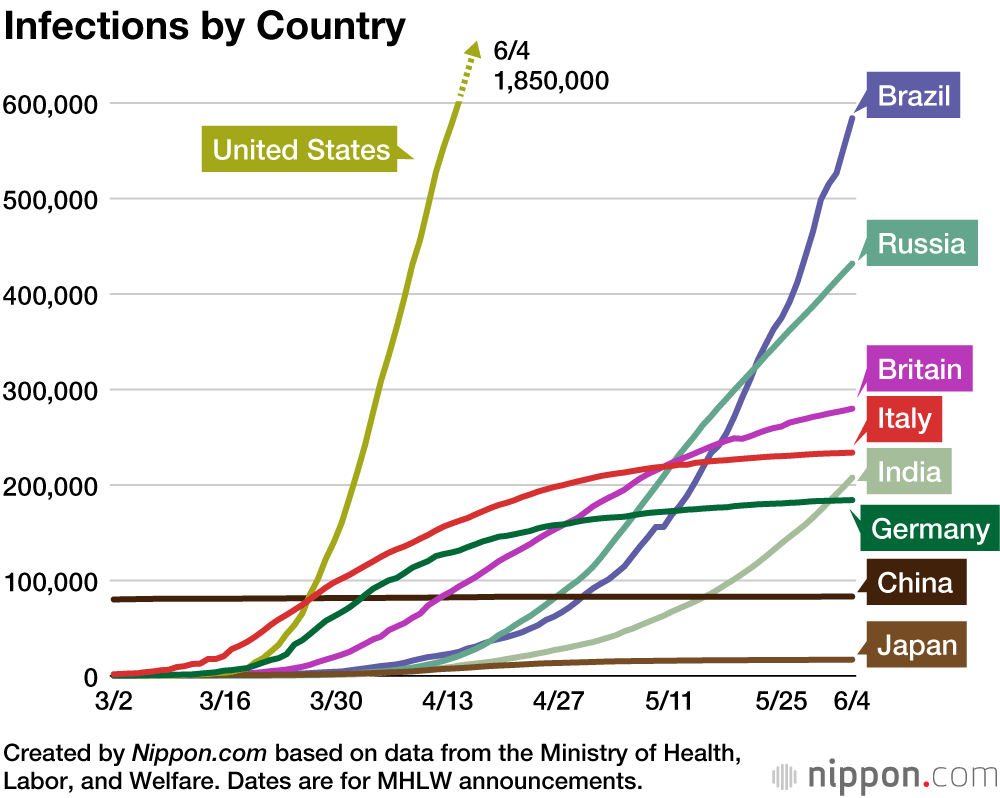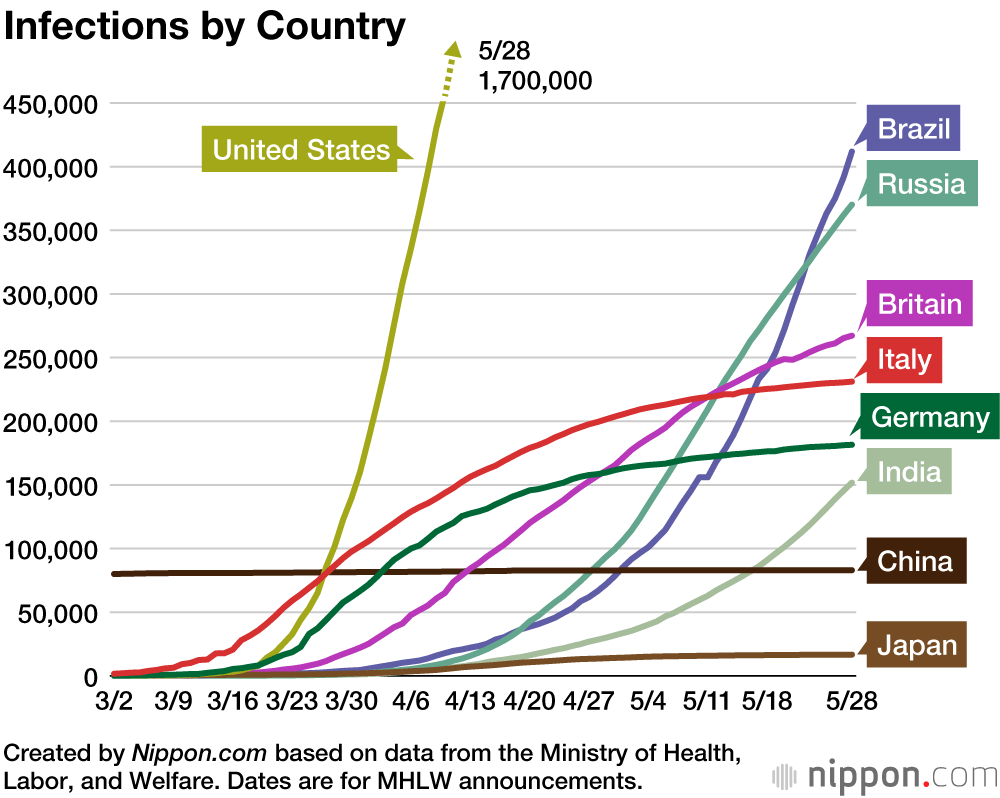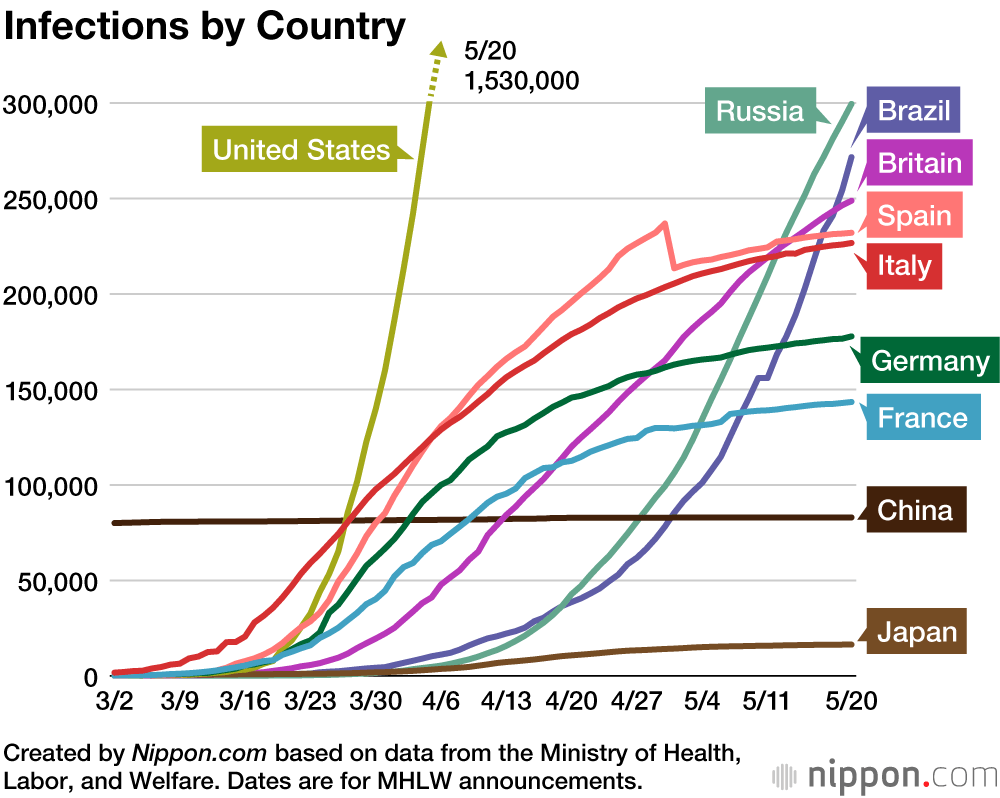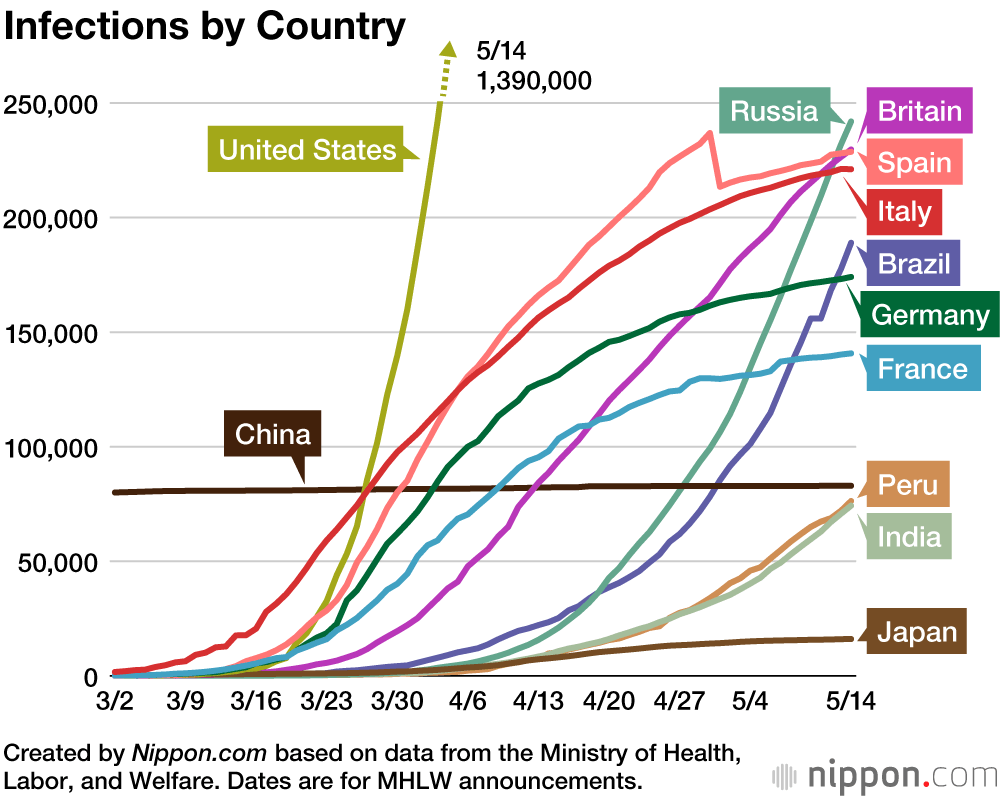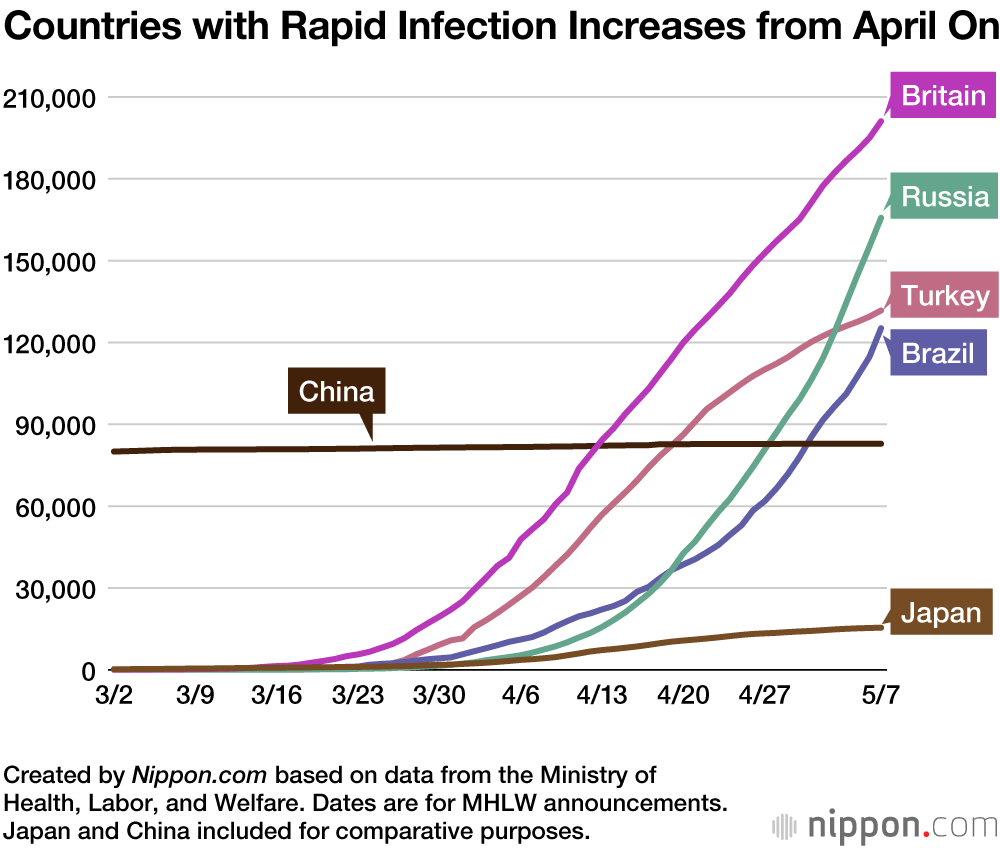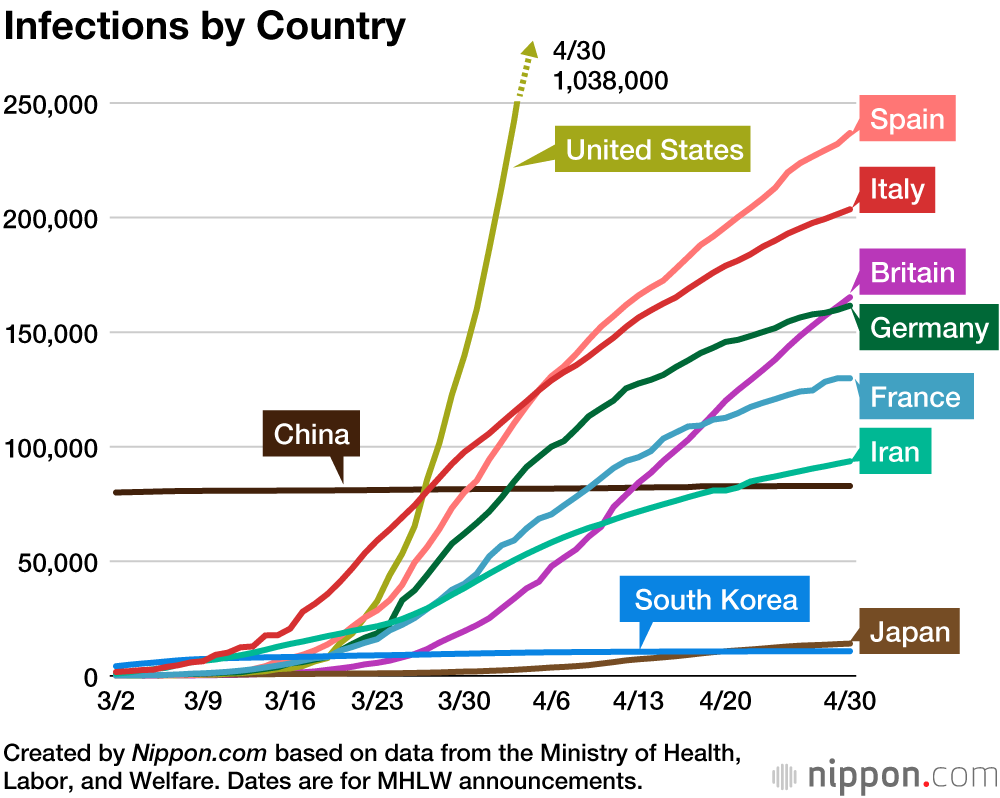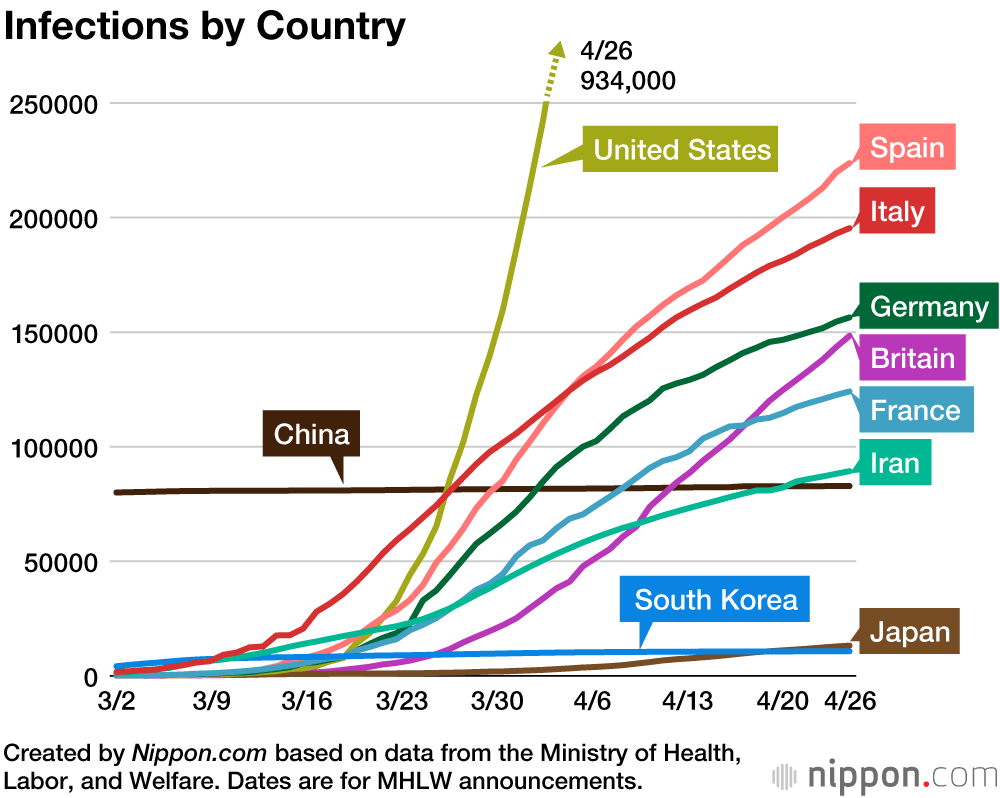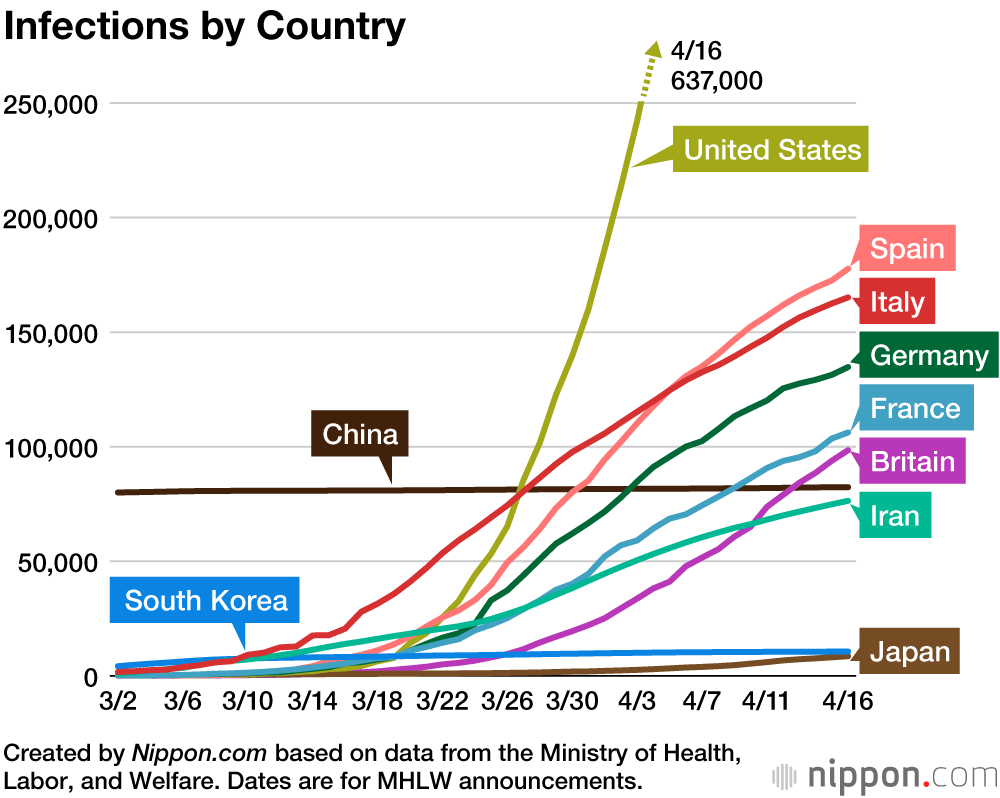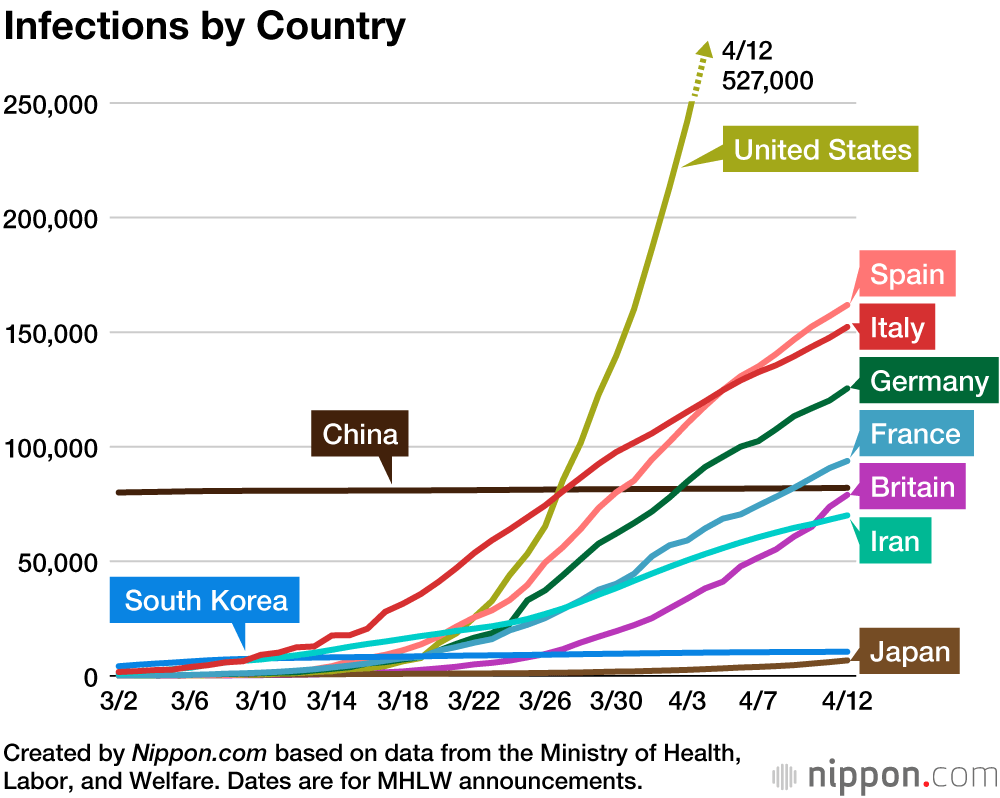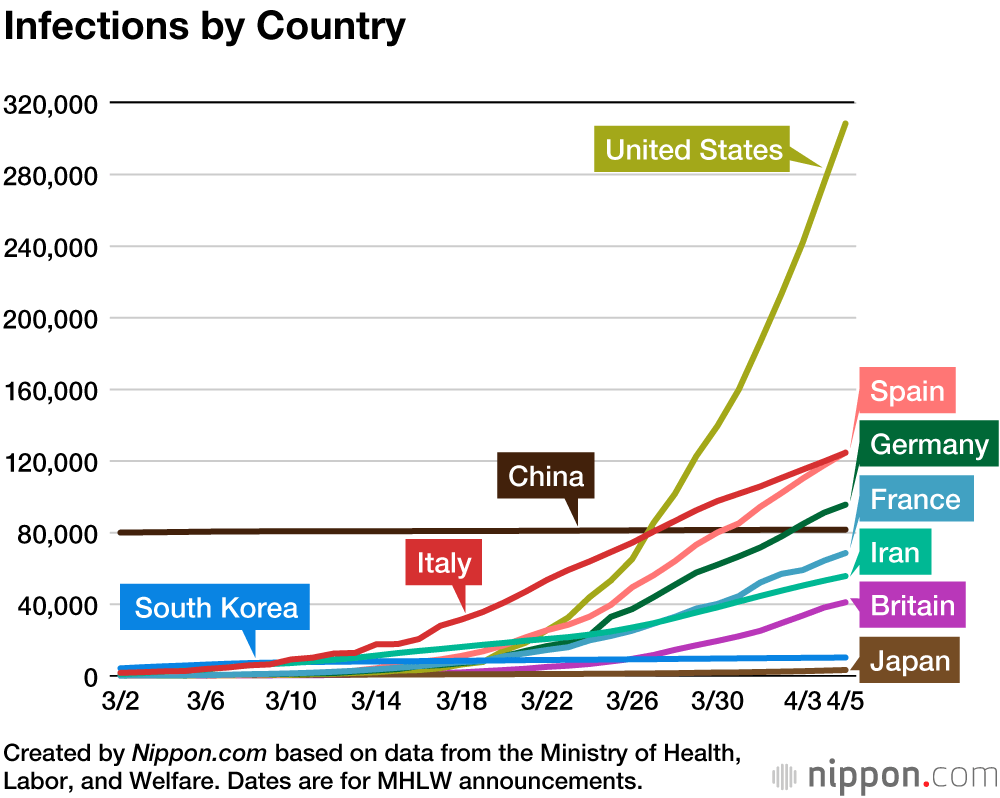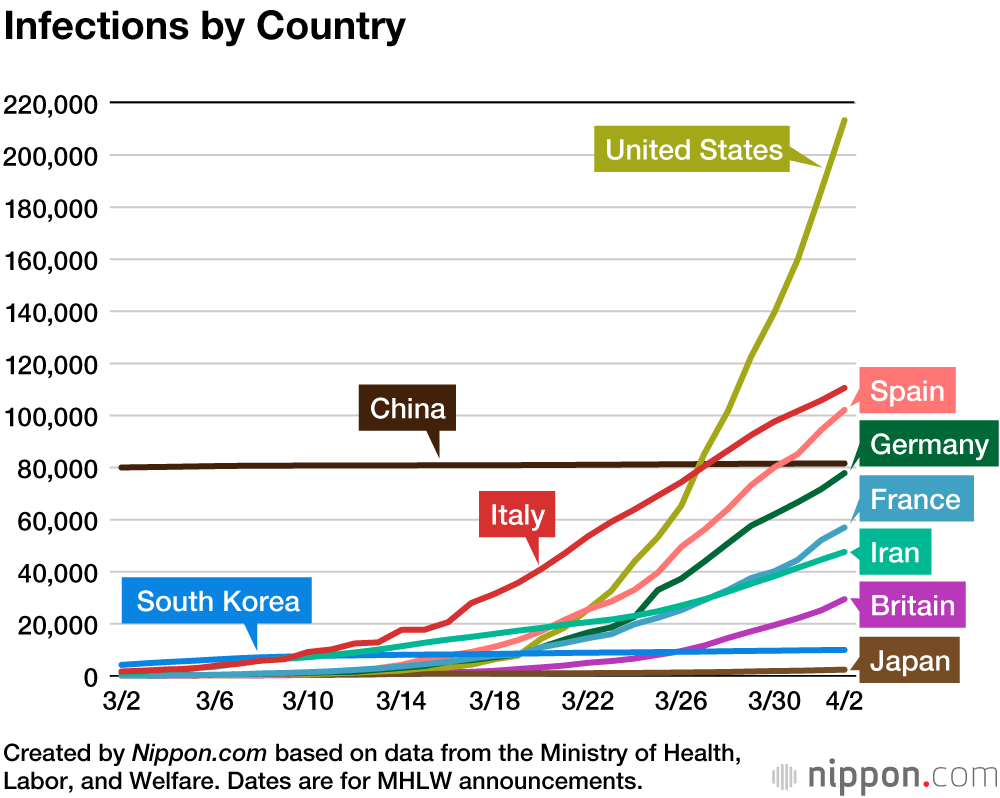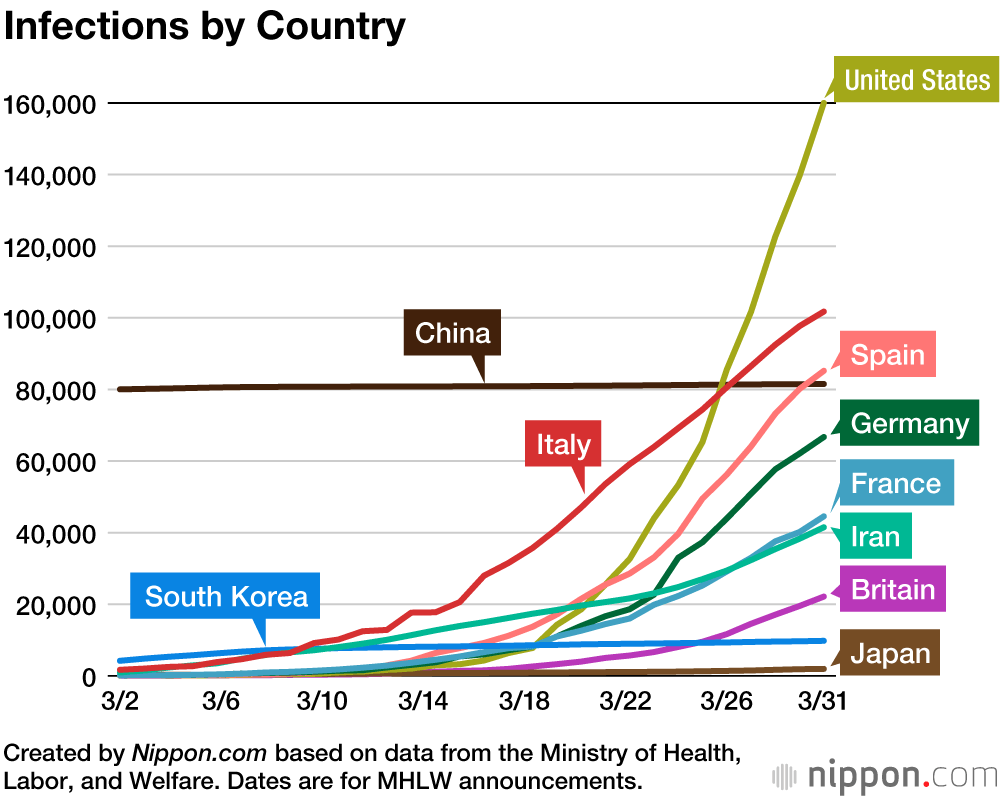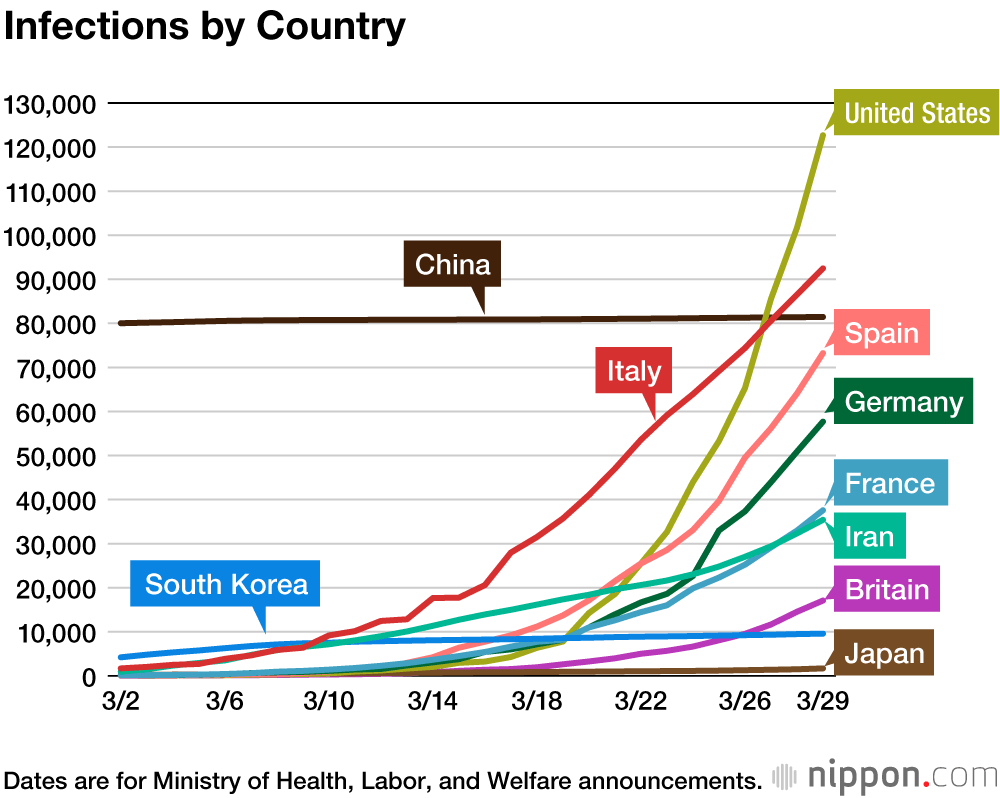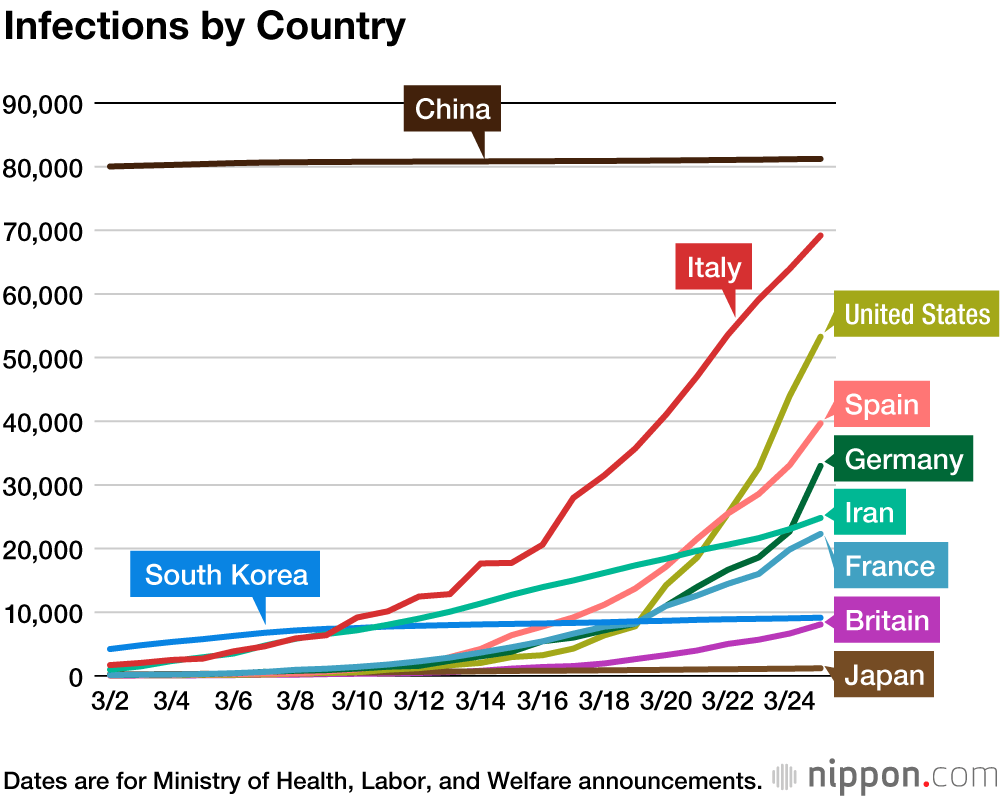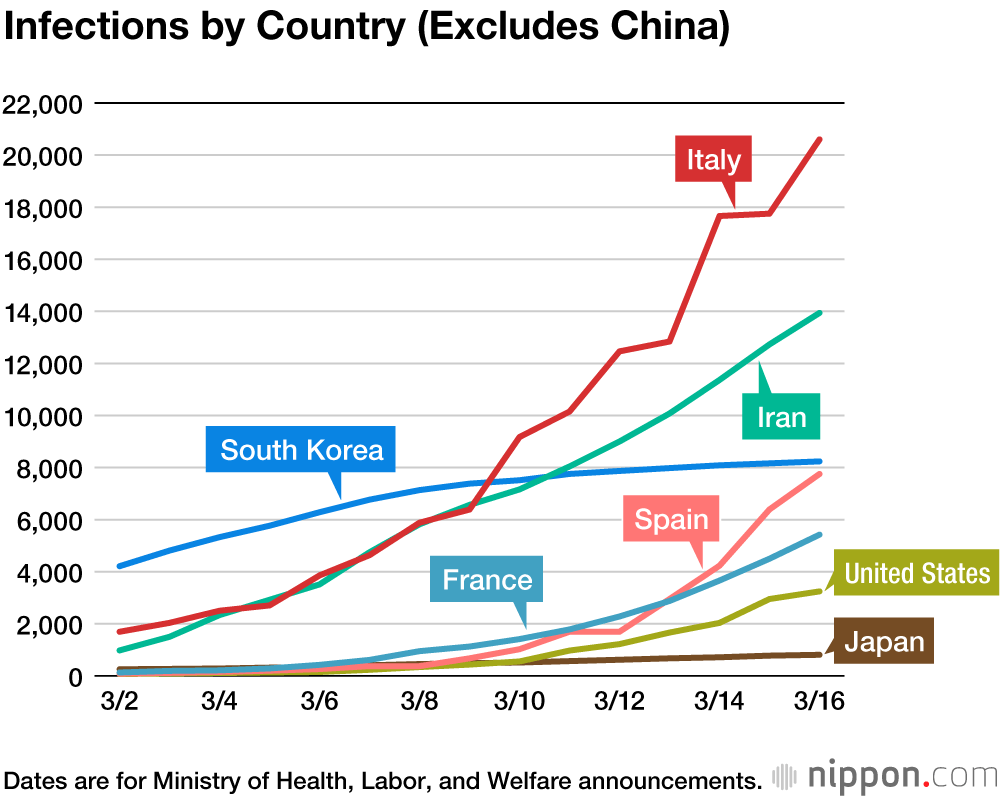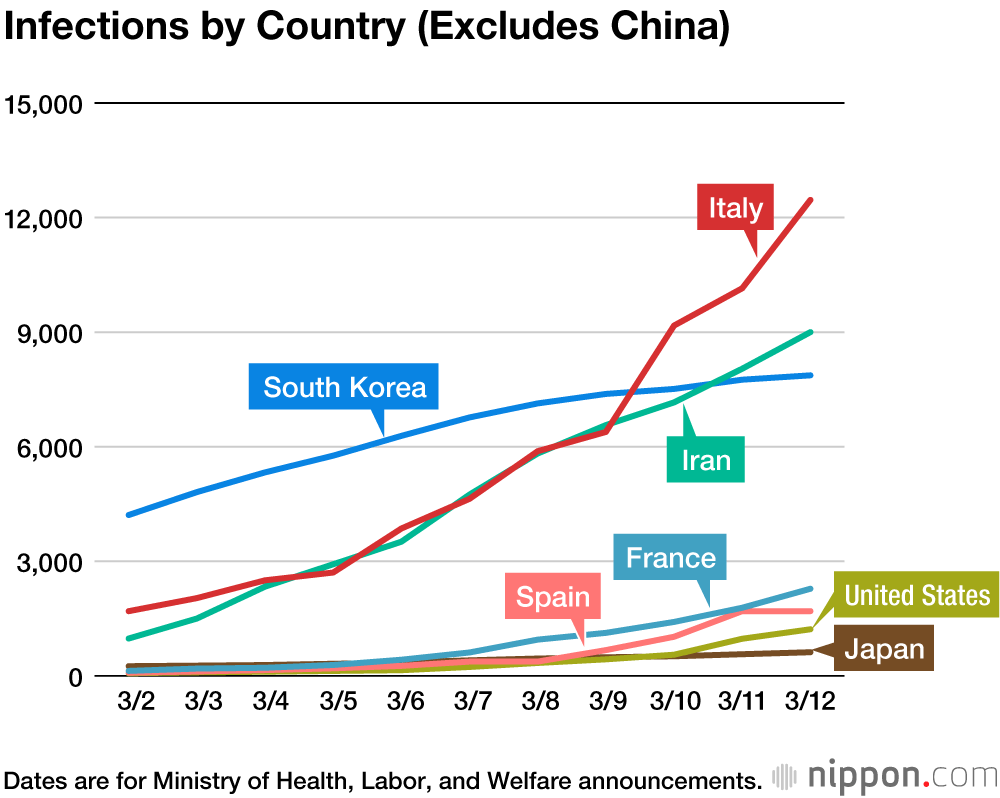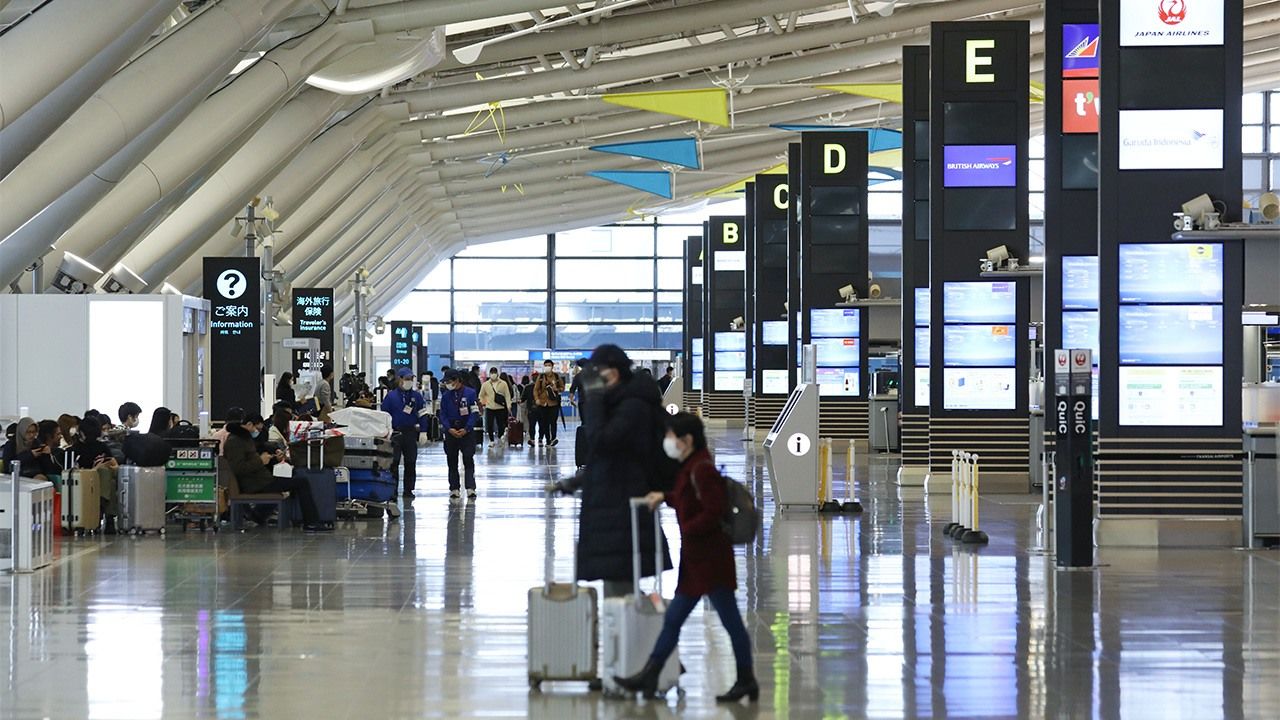
Coronavirus Cases by Country
Health Society Disaster- English
- 日本語
- 简体字
- 繁體字
- Français
- Español
- العربية
- Русский
(Data provided through the FastAlert real-time COVID-19 data service from JX Press.)
Click here for information on Japanese infections by prefecture and news updates.
January 16
There are now more than 2 million fatalities worldwide, according to statistics from Johns Hopkins University. The total number of cases is at 93.8 million. Vaccination has begun in some countries, but there is still no sign of the pandemic coming to an end. The United States has been hardest hit, with 23.5 million cases and 390,000 fatalities; it continues to record around 200,000 new cases each day. India has had 10.5 million cases and Brazil 8.4 million. A COVID-19 variant continues to spread in Britain, which is recording around 50,000 or 60,000 new cases each day.
January 5
There are now 85.7 million cases worldwide, according to statistics from Johns Hopkins University. Britain recorded its highest daily total to date of 59,000 on January 4, and England has now gone into a national lockdown. The United States is reporting around 200,000 cases every day.
January 2
The United States now has more than 20 million cases, according to statistics from Johns Hopkins University, accounting for 24% of the global total of 83.7 million. It has had 347,000 fatalities. As people traveled across the country around the Christmas holiday, almost 200,000 new cases were being reported every day, while the vaccination program has not made as much progress as initially planned.
December 12
There are now 70 million cases worldwide, according to statistics from Johns Hopkins University. Total fatalities have reached 1.6 million. The United States has 15.9 million cases, or around 23% of the global total, with around 200,000 new cases being reported every day.
December 9
The total number of cases in the United States exceeds 15 million. According to statistics from Johns Hopkins University, the United States has 15.2 million cases, or 22% of the global total of 68.3 million. Japan’s overall total is still less than 170,000, but the United States has recently recorded from around 180,000 to 200,000 new cases each day.
December 8
Britain begins its mass vaccination program, initially for healthcare workers and residents aged over 80.
November 26
The worldwide total has now reached 60 million cases, according to statistics from Johns Hopkins University, with 1.4 million fatalities. Some 20% of cases, or 12.6 million, are in the United States, which has recently regularly had daily totals of around 160,000 or 170,000, or more than the overall number to date in Japan. Infections continue to spread in European countries like Britain, Italy, and Spain.
November 14
There are now 53.5 million global cases, according to statistics from Johns Hopkins University. The top three countries account for 47% of the total, with 10.7 million in the United States, 8.8 million in India, and 5.8 million in Brazil. The daily total in the United States continues to climb, reaching a record of 180,000. Infections are also high in European countries like France, Germany, and Italy.
November 10
The United States now has 10.1 million cases, according to statistics from Johns Hopkins University, with 238,000 fatalities. It accounts for around 20% of the 50.9 million cases worldwide. While the number of daily cases in the country had diminished for a period, as winter approaches it is recording more than 100,000 new infections each day. Cases are also soaring in France, which has overtaken Russia, and has the fourth highest total overall.
October 20
There are now 40 million cases worldwide, according to statistics from Johns Hopkins University. The top three countries account for 52% of the total, with 8.2 million cases in the United States, 7.6 million in India, and 5.2 million in Brazil. In its first major wave, the US daily total rose above 70,000 in late July, gradually decreasing to drop below 40,000 in September. But increased spread from October, particularly in the Midwest, has led cases to approach their former peak. European countries like Spain, France, and Britain have also seen major rises in daily cases since September.
October 18
There has been a recent surge in cases in Europe. In particular, Spain has more than 900,000, and is rapidly approaching the 1 million mark; France has over 800,000; and Britain over 700,000.
October 2
US President Donald Trump announces on Twitter that he and First Lady Melania Trump have tested positive for COVID-19. This comes after a positive test for his aide Hope Hicks. President Trump has been negative about the idea of wearing masks and has frequently appeared in public without one.
September 29
There have now been more than 1 million COVID-19 fatalities worldwide, according to statistics from Johns Hopkins University, including 205,000 in the United States, 142,000 in Brazil, and 95,000 in India. On September 28, India topped 6 million cases. From September, India has reported around 80,000 to 90,000 new cases daily, and is catching up with the United States, which has has 7.1 million cases.
September 23
The United States now has more than 200,000 fatalities, according to statistics from Johns Hopkins University. It also has the highest total cases worldwide at 6.9 million. In April, its number of daily fatalities topped 2,000, before dropping in early July to around 500, then rising to around 800 recently.
September 22
US President Donald Trump makes a speech to the United Nations General Assembly, in whch he comments, “The United Nations must hold China accountable for their actions,” criticizing the country’s handling of the COVID-19 crisis.
September 18
There are now 30 million cases worldwide, according to statistics from Johns Hopkins University. The top three countries account for 54% of the overall total with 6.7 million in the United States, 5.1 million in India, and 4.4 million in Brazil. India is reporting more than 90,000 cases each day and steadily closing the gap on the United States.
September 7
India now has the second highest number of cases worldwide with 4.2 million, ahead of Brazil with 4.1 million, according to statistics from Johns Hopkins University. India has had 72,000 fatalities. From mid-August it reported daily cases from 70,000 to over 80,000, but this figure has recently risen above 90,000. Even in the capital, New Delhi, where a reduction in cases encouraged reopening of the economy, there has been a renewed increase in infections.
September 4
Brazil now has more than 4 million cases and 125,000 fatalities, according to statistics from Johns Hopkins University. It is second for both categories behind the United States, but India has almost as many cases, with 3.9 million.
August 27
There are now 24.1 million cases worldwide, according to statistics from Johns Hopkins University. More than half of all cases have been reported in the top three countries: the United States (5.8 million), Brazil (3.7 million), and India (3.2 million). The pace in the United States has slowed from around 60,000 daily cases in the second half of July to around 40,000 now. By contrast, the pace in India has increased to around 60,000 daily cases.
August 11
Statistics from Johns Hopkins University show that there are now 20 million cases worldwide. It took around six months from the first reports in Wuhan to reach 10 million cases on June 28. From then, it was just 44 days until the total reached 20 million. More than half of all cases have been reported in the top three countries: the United States (5.1 million), Brazil (3.1 million), and India (2.2 million).
August 7
There are now 19.1 million cases worldwide, according to statistics from Johns Hopkins University. Having topped 17 million on July 30 and 18 million on August 3, the current pace of increase is around 1 million every four days. More than half of all cases have been reported in the top three countries: the United States, Brazil, and India. There has also been a notable recent increase in infections in South Africa and other African countries.
August 3
Statistics from Johns Hopkins University show that there are now 18 million cases worldwide and there have been 689,000 fatalities. More than half of all cases have been reported in the top three countries: the United States, Brazil, and India.
July 26
Statistics from Johns Hopkins University indicate that there are now 16 million cases worldwide. It took just three days to rise from 15 million. Around half of all cases have been reported in the top three countries: the United States, Brazil, and India.
July 24
The United States now has more than 4 million cases, according to statistics from Johns Hopkins University, representing around a quarter of all cases worldwide. The pace of growth has increased in the country from mid-July and it is currently reporting 50,000–70,000 new cases each day.
July 23
Statistics from Johns Hopkins University show that there are now more than 15 million cases worldwide. Almost half of the total cases have been reported in the top three countries: the United States, Brazil, and India. There are also rapid increases in infections in Latin America and Africa.
July 19
World Health Organization statistics indicate that there were a record 259,848 new cases on July 18. The United States reported more than 70,000 for a second successive day, as the pace of growth increases. There are also rapidly increasing cases in Latin American countries like Brazil, Mexico, and Peru, as well as India and South Africa.
July 17
Statistics from John Hopkins University show that Brazil now has more than 2 million cases and India more than 1 million. The two countries have the second and third highest totals after the United States, with 3.6 million.
July 14
Statistics from Johns Hopkins University indicate that the total number of worldwide cases has reached 13 million. The current global pace is 1 million new cases every five days, with the United States, Brazil, and India showing the greatest increases.
July 12
The WHO’s figures indicate 230,370 new cases for the day globally, breaking the July 10 record of 228,000. The Americas now have a total of 6.54 million cases, or more than half of the global total. Southern and Western states in the United States are seeing infections climb at an accelerating rate; the country has seen some 60,000 new cases each day for four days in a row, according to Johns Hopkins University.
July 11
Johns Hopkins University statistics show Brazil to have passed 1.8 million total infections, after seeing 30,000–50,000 new cases detected each day for several days running. Brazilian President Jair Bolsonaro, however, remains opposed to restrictions that might impact the economy.
July 9
Statistics from Johns Hopkins University show that the United States now has 3 million cases, accounting for around one quarter of the 12 million cases worldwide. States like Florida, Texas, and Arizona face an increasingly serious situation.
July 8
Brazilian President Bolsonaro announces that he has tested positive for COVID-19 (July 7 local time). Brazil has the second highest number of cases worldwide after the United States. Bolsonaro has played down COVID-19 as being like flu, refused to wear a mask, and criticized economic restrictions introduced by local governments to contain the outbreak.
July 6
India’s total cases rise to 697,000, meaning it now has the third highest number behind the United States and Brazil. As Pakistan has 230,000 and Bangladesh 160,000, South Asia is currently experiencing rapid growth second only to that in the Americas.
July 4
World Health Organization statistics show the highest daily total for new cases to date at 212,326. Cases are rapidly increasing in the United States, Brazil, and India.
June 29
The number of global fatalities rises above 500,000, according to statistics from Johns Hopkins University. It is around six months since the first reports emerged of a pneumonia outbreak of unknown cause in Wuhan, China. There have been 125,700 fatalities in the United States and 57,000 in Brazil, and these two countries account for more than a third of the overall total.
June 28
The number of global cases rises above 10 million, according to statistics from Johns Hopkins University. Brazil reports 40,000 new cases again, while continuing record numbers of daily cases in the United States increase fears of a second wave. Cases are also increasing rapidly in South Asia.
June 27
Statistics from John Hopkins University show that the United States sets a record for new daily cases with more than 45,000, with the situation becoming more serious in southern states like Florida and Texas. Brazil also reports around 40,000 new cases for the fourth successive day, while India reports 18,000 to bring its total above 500,000.
June 26
The United States reports more than 40,000 new cases for the first time. States like Texas, California, Florida, and Arizona in the south and west have seen particularly rapid increases as the country’s second wave takes shape. Brazil has reported around 40,000 cases for three successive days, and the Americas are becoming the epicenter of the pandemic. However, cases are also increasing in South Asia and the Middle East.
June 25
There are now 9.5 million cases worldwide according to statistics from Johns Hopkins University, with 480,000 fatalities. The United States has reported more than 30,000 daily cases over the past three days, as a second wave takes shape. Brazil has had between 20,000 and 40,000 daily cases almost every day through June. The pace of infections is also increasing in India, Pakistan, Bangladesh, and the Middle East.
June 23
Statistics from Johns Hopkins University show that there are now 9 million cases worldwide, with 470,000 fatalities. The number of cases is contininuing to grow rapidly in Brazil, Peru, and Chile, while the pace of growth is starting to increase in India and the Middle East. The World Health Organization warns that the pandemic is accelerating.
June 20
Brazil now has more than 1 million cases, according to statistics from Johns Hopkins University, and almost 50,000 fatalities. It is the second country to reach 1 million cases after the United States. Although the number of cases started to increase in late March, President Jair Bolsonaro has opposed such preventive measures as staying indoors. Poor favela neighborhoods in urban areas have been particularly hard hit.
June 18
Statistics from John Hopkins University show that the number of cases in Brazil increase by 32,000 in one day to 955,000. Brazil has the second highest number of cases worldwide after the United States. There are now three South American countries in the global top 10 for cases, as Peru is seventh with 241,000 and Chile is ninth with 221,000.
The following graph zooms in to focus on changes in Japan and South Korea. In Japan, there was a rapid increase from early April to mid-May, but this has slowed down since. The reopening of the economy in late May in South Korea has brought a slight increase in the pace of growth in infections.
June 11
The United States now has 2 million cases, according to statistics from Johns Hopkins University, with 113,000 fatalities. Both represent 27% of the global total.
June 8
Today’s Ministry of Health, Labor, and Welfare report shows that India now has almost 250,000 cases, the fifth highest worldwide, ahead of Spain and Italy.
Statistics from Johns Hopkins University show that there are now 7 million cases worldwide and 400,000 fatalities. Brazil has seen a particularly rapid rise from May and now has more than 600,000 cases.
June 4
The number of cases in Brazil continues to increase rapidly, and has now reached a total of 584,000 after growing by 29,000 over each of the past two days.
June 1
The number of cases in Brazil has grown sixfold in one month, from 85,000 on May 1 to 515,000 on June 1. Peru and Chile are also seeing a rise in cases, while Russia now has more than 400,000.
May 31
Statistics from Johns Hopkins University show that there are now 6 million cases worldwide, 10 days after the global total reached 5 million. The United States has the most cases with 1.8 million. While the pace of increase has slowed in Europe, the number of cases has grown more than fivefold in Brazil in May to 465,000. Infections continue to spread in other Latin American countries like Peru, Chile, and Mexico.
May 29
Brazil’s total number of cases has grown fivefold in less than a month, from 85,000 on May 1 to 438,000 on May 29. There have also been significant rises in other Latin American countries like Peru, Chile, and Mexico.
May 28
The United States has now experienced more than 100,000 fatalities, according to statistics from Johns Hopkins University. While its pace of increase has dropped overall, some areas that have reopened their economies have seen a rising number of infections, and the battle with the coronavirus is far from over in the country. Worldwide, there are now 5.7 million cases and more than 350,000 fatalities.
May 26
Johns Hopkins University statistics show that there are now 5.5 million cases worldwide with more than 340,000 fatalities. While the pace of increase has slowed in Europe and the United States, the overall total is being driven by rises in Brazil and Russia, which now both have more than 350,000 cases. The number of cases continues to rise quickly in Peru, Chile, and Ecuador.
May 23
Brazil now has 330,000 cases, the second highest total worldwide, according to statistics from Johns Hopkins University. In April, infections started to spread in Brazil, with the pace increasing from May. The country has had more than 20,000 fatalities. As President Bolsonaro plays down COVID-19 as a “little flu” and calls for reopening the economy early, infections appear set to spread further. The number of cases is also increasing rapidly in Peru, Chile, and Ecuador.
May 21
Statistics from Johns Hopkins University show that there are now more than 5 million cases worldwide. With 1.6 million, the United States accounts for 30% of these. While the pace of growth has dropped in many European countries that saw rapid increases from March to April, Russia and Brazil have experienced explosive increases since mid-April, with both now having around 300,000 cases. Peru and Mexico are also seeing rapid increases, as Latin America is becoming a new epicenter of the pandemic.
May 19
The United States now has more than 1.5 million cases, according to statistics from Johns Hopkins University, with over 90,000 fatalities. It accounts for around a third of the 4.8 million cases worldwide, and New York State alone has 350,000.
May 17
As the pace of increase in new infections slows in Europe, social and economic activities begin to restart, including Bundesliga soccer matches in Germany. Elsewhere, however, rapid growth in Russia and Brazil continues, the number of cases in Peru and India each rise above those for China, and Saudi Arabia has more than 50,000 cases.
May 15
Statistics from Johns Hopkins University show that there have now been over 300,000 fatalities worldwide. The United States has had most with 85,000, followed by Britain with 34,000, and Italy with 31,000. The total number of infections is at 4.4 million, with the United States accounting for around a third with 1.4 million. While the pace of growth is now slowing somewhat in Europe and the United States, it is rising in South America and South Asia.
May 13
With more than 230,000 cases, Russia now has the second highest total worldwide, according to statistics from Johns Hopkins University. It managed to keep its total low until early April, but showed a rapid rise from the mid-April period. Its reported fatalities are still only just over 2,000, however, which is an order of magnitude lower than countries like Spain, Britain, and Italy with a similar number of infections.
May 12
Statistics from Johns Hopkins University show that the United States has now had more than 80,000 fatalities with 1.34 million cases. Both represent around a third of the global total. Russia has 220,000 cases, leaving it just behind Britain and Spain, which have the highest totals for Europe.
May 10
British Prime Minister Boris Johnson announces a planned gradual easing of the lockdown imposed since March. This will include lifting the restriction allowing people to go outside for exercise only once a day and encouraging the restart of industries where working from home is impossible, such as manufacturing and construction. Retailers would then be able to restart business from June. Britain has more than 200,000 cases, and has the second highest number of fatalities worldwide after the United States, with 31,500.
Johns Hopkins University statistics show that the United States has 1.3 million cases, accounting for around a third of the global total. Russia cannot slow down its own rise, with cases approaching 210,000, while the pace of growth is also climbing in Brazil and India. Meanwhile, in China and South Korea, where new cases had almost stopped, measures aimed at easing restrictions have led to new clusters.
The number of global cases hits 4 million, according to statistics from Johns Hopkins University, while fatalities reach 278,000. It is 12 days since the total cases hit 3 million on April 28. While the pace of increase has dropped in Italy and Spain, it is rising in countries like Russia, Brazil, and Peru.
May 8
The US Labor Department publishes statistics showing that unemployment rose from 4.4% in March to 14.7% in April, its highest level since the end of World War II. The loss of 20.5 million jobs is the largest drop since statistics were first kept in 1939.
Statistics from Johns Hopkins University show that the number of cases worldwide has risen above 3.86 million, with fatalities approaching 270,000. The United States has reached 1.25 million cases, while in Europe, the number of cases in Britain is approaching that for Italy and Spain, where the pace of growth has slowed. Russia has seen a rapid increase in infections since the start of May and now has the fifth highest number worldwide. Both Russia and Brazil are recording 10,000 new cases daily.
May 6
Cases in Britain continue to climb, as its fatalities rise above 30,000 to reach the second highest total worldwide, ahead of Italy but behind the United States. With its third straight day of 10,000 or more new cases, Russia sees its total rise above 150,000. In South America, Brazil now has 110,000 cases overall, and Peru 50,000.
Statistics compiled by Johns Hopkins University indicate that the United States has suffered 70,000 fatalities. This amounts to 27.7% of the global total. It also has more than 1.2 million cases, or 32.8% of the total worldwide.
May 5
The number of global fatalities reaches 250,000, according to statistics from Johns Hopkins University. The figure has quintupled in around a month from 50,000 on April 3.
May 4
Statistics from Johns Hopkins University show that the number of global COVID-19 cases have now risen above 3.5 million. The pace of increase has slowed in countries like Italy, Spain, and France, but Russia records its first day of 10,000 new cases. In South America, Brazil now has 100,000 cases and Peru 45,000.
May 1
World Health Organization Director-General Tedros Adhanom Ghebreyesus extends the body’s declaration of a global health emergency over the coronavirus. This comes some three months after it made an initial statement of emergency on January 30. While the outbreak appears to have passed its peak in some countries, there are still concerns about further growth in infections in areas with more limited medical resources.
Russia appears unable to stop the spread of infections, despite going into lockdown from the end of March, and now has 106,000 cases. On April 30, Prime Minister Mikhail Mishustin announced that he had tested positive and began self-isolating.
April 30
New York State reports more than 300,000 cases. In the United States, which now has 1 million cases, there are moves toward restarting economic activities in many states, but New York Governor Andrew Cuomo remains cautious on the matter.
April 29
The US Commerce Department announces that GDP fell at a 4.8% annual rate in the United States in the first quarter of 2020, its biggest drop since the 8.4% decrease in the last quarter of 2008.
The United States now has more than 1 million cases, according to statistics from Johns Hopkins University. It accounts for around a third of the global total of infections and a quarter of fatalities.
April 28
Johns Hopkins University statistics show that there have now been more than 3 million global COVID-19 cases. The United States has had 973,000, approaching one third of the total, while cases in the United States, Spain, Italy, Germany, France, and Britain add up to more than 60%.
April 26
According to statistics from Johns Hopkins University, there have now been more than 200,000 COVID-19 fatalities worldwide. Of these 53,000 took place in the United States, 26,000 in Italy, 22,000 in both Spain and France, and 20,000 in Britain. These five countries account for 140,000 deaths, or 70% of global fatalities. The total number of cases stands at 2.88 million, of which 926,000 are in the United States.
April 25
In South America, where the outbreak is becoming more serious, the number of cases in Brazil rises above 50,000, while both Ecuador and Peru have more than 20,000.
April 24
The number of global cases rises by more than 80,000 in one day to 2.66 million, and fatalities approach 190,000. In China and South Korea, which suffered many infections in the early stages of the outbreak, there are just 6 new cases each and no fatalities.
April 20
The New York Mercantile Exchange crude oil price turns negative for the first time ever due to plummeting demand, falling to –$37.63 per barrel.
April 19
Statistics from Johns Hopkins University show that there have been more than 2.3 million COVID-19 cases and more than 160,000 fatalities. The United States has had about 30% of the global total at 720,000 cases, while New York State alone has had 240,000 cases and 12,000 fatalities.
April 18
The number of global COVID-19 deaths rises above 150,000, according to statistics from Johns Hopkins University. Of these, 36,700 took place in the United States, 22,700 in Italy, and 19,600 in Spain.
April 16
April 15
Statistics from Johns Hopkins University show global totals of over 2 million cases and more than 130,000 fatalities. The United States has 640,000, or around a third of all cases. New York State alone has recorded 213,700 cases and 11,000 fatalities.
April 12
The United States now has 524,903 cases and 20,389 fatalities, according to statistics from Johns Hopkins University. Its fatalities now exceed those of Italy. Around 40% of US deaths have taken place in New York State.
The graph below, capped at 250,000 cases to make it easier to compare national figures, does not encompass the far higher US total of more than 500,000. While the pace of increase in Italy has slowed somewhat, it is accelerating in Spain and Britain.
April 11
Statistics from Johns Hopkins University show that there have now been more than 100,000 COVID-19 fatalities worldwide. Of these 73% took place in Italy, the United States, Spain, France, and Britain.
April 5
The number of cases in the United States rises to 300,000, of which 120,000 are in New York State. There are 1.17 million cases worldwide, of which around half are in the United States, Spain, and Italy. These three countries also account for 55% of global fatalities, with a combined total of 35,397.
April 4
At 277,000, the number of cases in the United States rises to a quarter of the global total. New York State alone has 113,000, or around the same as Italy and Spain combined.
April 3
The total number of cases worldwide rises over 1 million, and there have now been more than 50,000 fatalities. At 240,000, the United States accounts for almost a quarter of all infections. In Europe, both Italy and Spain have had more than 100,000 cases and 10,000 fatalities. Restrictions in both countries on going outside and substantive halts to economic activities have shown little effect in slowing down the spread of infections.
The number of infections in the United States rises 27,000 in one day to over 210,000. New York State now has more than 83,000 cases, which is more than the officially given total for China. The number of cases in Spain approaches the figure for Italy.
April 1
The Wimbledon tennis tournament is canceled for the first time since World War II. It had been set to take place from June 29 to July 12.
March 31
Ministry of Health, Labor, and Welfare statistics, as of noon of March 31, show that the United States has 162,000 cases. Some 40% of these, or 66,497 cases, are in New York State. The number of cases in Italy increases above 100,000, while infections continue to rise in Spain and Germany.
March 29
MHLW statistics, as of noon of March 29, show that the United States has 122,666 cases, or around five times as many as the 25,494 cases of a week earlier. New York State is most seriously affected, with 52,318 cases. Fatalities in Italy have risen above 10,000, while infections continue to rise rapidly in Spain and Germany.
March 27
British Prime Minister Boris Johnson announces that he has tested positive for the coronavirus, and that he is self-isolating with mild symptoms.
March 26
Statistics from Johns Hopkins University show the United States as now having the most number of cases worldwide with 83,507, followed by China with 81,782, and Italy with 80,589. New York State alone has 37,258 cases and faces shortages of hospital beds and respirators.
March 25
Prince Charles of Britain is reported to have been infected. He has mild symptoms and is self-isolating.
March 23
The Canadian Olympic Committee announces that Canada will not send a team to the Tokyo 2020 Games, urging the events to be postponed for one year. The Australian Olympic Committee, too, states that “Australian athletes should prepare for a Tokyo Olympic Games in the northern summer of 2021.”
March 22
Italy’s health ministry announces that the number of infections nationwide has risen to 59,138 and related fatalities to 5,476. Prime Minister Giuseppe Conte says the country is facing its gravest crisis since World War II and that all activities will be shut down apart from those that are strictly necessary.
March 20
New York Governor Andrew Cuomo announces a stay-at-home order applying to all nonessential workers within the state to go into effect from March 22. California also issued a stay-at-home order on March 19.
March 16
March 15
The German government shuts down borders with France, Switzerland, Austria, Denmark, and Luxembourg for an indefinite period. The only exemptions are for transportation of goods, commuters, and citizens returning to the country.
March 14
Spain enters a state of national emergency, as Prime Minister Pedro Sánchez imposes a lockdown in which people should only go out to buy necessary supplies. His wife Begoña Gómez tests positive for the coronavirus.
March 13
US Major League Baseball delays the start of its season, fixtures in soccer leagues across Europe and the US Masters golf tournament are postponed, and tennis tours are disrupted.
US President Donald Trump declares a state of national emergency, making $50 billion available to tackle the coronavirus outbreak.
March 12
March 11
In New York, the Dow Jones industrial average plunges over 1,400 points. President Trump announces new measures, including an entry ban from European countries, excluding Britain.
World Health Organization Director-General Tedros declares the coronavirus outbreak a pandemic and calls on countries to take “urgent and aggressive action” to contain it.
Italy becomes the second country after China to report more than 10,000 cases. The number of people infected has more than doubled from 4,636 as of March 7 to 10,149.
March 10
As the number of infections in Italy spikes, the Japanese government decides to refuse entry to people who have been in Lombardy and four other provinces of the country.
(Originally published in Japanese. Banner photo: The largely deserted departures lobby at Kansai International Airport on March 9, 2020. © Jiji.)
